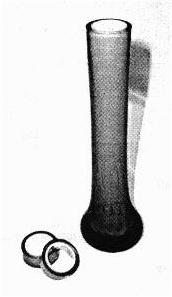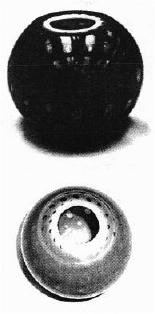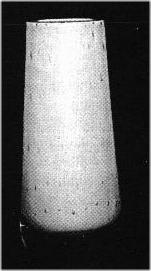National Cambridge Collectors, Inc.
A non-profit 501(c)(3) organization.

Cambridge Experimental Cased Glass
by Mike and Cindy Arent
Issue No. 353 - September 2002
During the reopened period, March 1955-1958, the Cambridge Glass
Company experimented with the idea of producing items of cased glass.
 The dictionary definition, of cased glass, "Blown glass consisting of
two or more fused layers of different colors of glass. The combined
colors are taken from the mold and reheated so the two layers of glass
fuse together."
The dictionary definition, of cased glass, "Blown glass consisting of
two or more fused layers of different colors of glass. The combined
colors are taken from the mold and reheated so the two layers of glass
fuse together."
We received a piece of Cambridge experimental cased glass as a gift from Cindy's aunt Mary Martha Mitchell. When she gave us this gift, she also wrote this short description describing the circumstances under which the glass was produced. Following is the text of that letter:
When the Cambridge Glass Company resumed operations after having been closed from August 1954 until March 1, l955, all of the previous customers were dissatisfied. Naturally, the customers were angry because they could not fill in their lines.
Tom Walshe, a former Cambridge Glass Company salesman in the Southeast became Sales Manager for the re-opened company. His thinking was that if we could manufacture some unusual items, we might be able to lure some of our customers back.
One of his ideas was to try to cased glass, which wasn't being done in the United States. It is a very difficult process and our workers were not able to master it. This vase was one of those pieces.
- Mary Martha Mitchell
Her written note does not describe what it was that the Cambridge
workers could not master, but she said it was the thickness of the
glass layer that was the problem. She had in her collection several
 pieces of what she called French cased glass. These pieces have an
inner layer of white glass 1/32 of an inch thick covered with an outer
pieces of what she called French cased glass. These pieces have an
inner layer of white glass 1/32 of an inch thick covered with an outer
 layer of colored glass 3/16 inches thick. In contrast, if you examine a
piece of the Cambridge cased glass, the layers vary in thickness from
piece to piece and are all much thicker. The Cambridge pieces shown in
the pictures have inner layers from 1/16 to 3/16 inches thick and outer
layers from 1/8 to 1/4 inches thick.
layer of colored glass 3/16 inches thick. In contrast, if you examine a
piece of the Cambridge cased glass, the layers vary in thickness from
piece to piece and are all much thicker. The Cambridge pieces shown in
the pictures have inner layers from 1/16 to 3/16 inches thick and outer
layers from 1/8 to 1/4 inches thick.
All other pieces which are shown in the pictures were once part of Aunt Mary Martha's collection. Four of the pieces consist of an inner layer of Milk Glass covered with an outer layer of Tahoe blue. The one other vase is Milk Glass covered with an outer layer of crystal.
In addition to being cased glass, the vases also have controlled bubble effect which appear to be between the two layers of glass. Although the bubbles do not show up well in the picture (at left), they cover the vases and are evenly spaced similar to the controlled bubbles found in Cambridge paper weights. The bubbles on the rose bowl are round, while on the cased vases they have been elongated as the neck of the vase was stretched. The napkin rings, shown in the first picture, do not have bubbles.
Although it is fairly certain that none of these pieces were ever production items, there are several other pieces known to exist. Examples of the Milk/Tahoe and Milk/Crystal vases can be seen at the NCC museum.